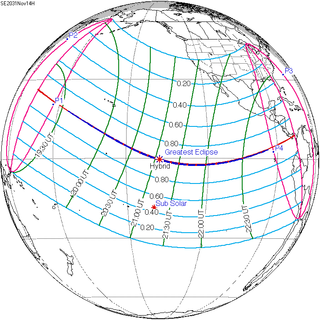| Solar eclipse of November 14, 2031 | |
|---|---|
| Type of eclipse | |
| Nature | Hybrid |
| Gamma | 0.3078 |
| Magnitude | 1.0106 |
| Maximum eclipse | |
| Duration | 68 s (1 min 8 s) |
| Coordinates | 0°36′S 137°36′W / 0.6°S 137.6°W |
| Max. width of band | 38 km (24 mi) |
| Times (UTC) | |
| Greatest eclipse | 21:07:31 |
| References | |
| Saros | 143 (24 of 72) |
| Catalog # (SE5000) | 9578 |
A total solar eclipse will occur at the Moon's ascending node of orbit on Friday, November 14, 2031,[1] with a magnitude of 1.0106. It is a hybrid event, with portions of its central path near sunrise and sunset as an annular eclipse. A solar eclipse occurs when the Moon passes between Earth and the Sun, thereby totally or partly obscuring the image of the Sun for a viewer on Earth. A total solar eclipse occurs when the Moon's apparent diameter is larger than the Sun's, blocking all direct sunlight, turning day into darkness. Totality occurs in a narrow path across Earth's surface, with the partial solar eclipse visible over a surrounding region thousands of kilometres wide. Occurring about 3.1 days before perigee (on November 17, 2031, at 22:00 UTC), the Moon's apparent diameter will be larger.[2]
Since most of the path of this eclipse is narrow and passes over the Pacific Ocean, no land areas will witness totality. However, annularity will be visible from parts of Panama near sunset. A partial eclipse will be visible for parts of northern Oceania, Hawaii, southern North America, Central America, the Caribbean, and northwestern South America.
- ^ "November 14, 2031 Total Solar Eclipse". timeanddate. Retrieved 14 August 2024.
- ^ "Moon Distances for London, United Kingdom, England". timeanddate. Retrieved 14 August 2024.
